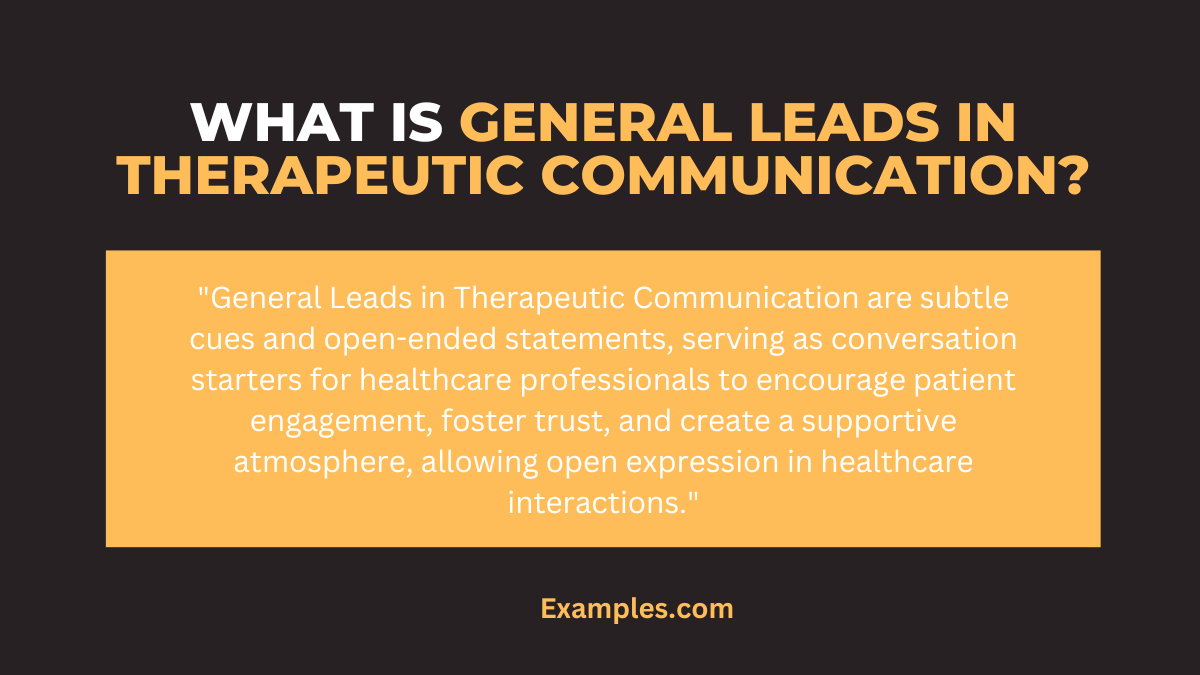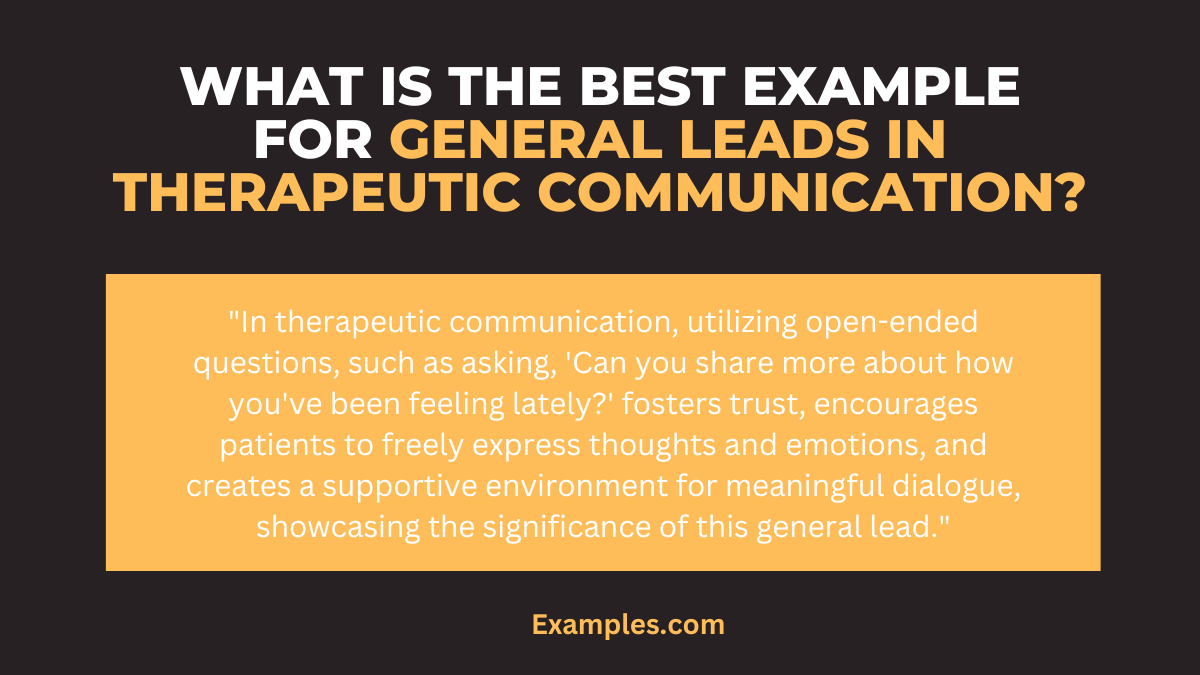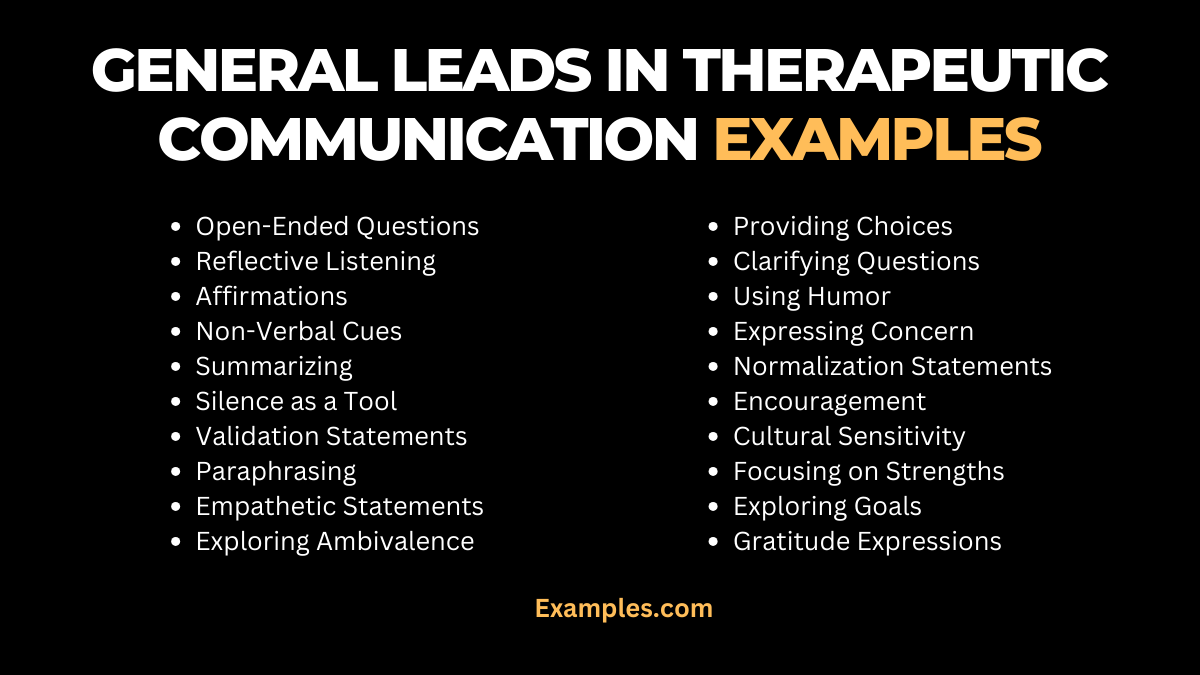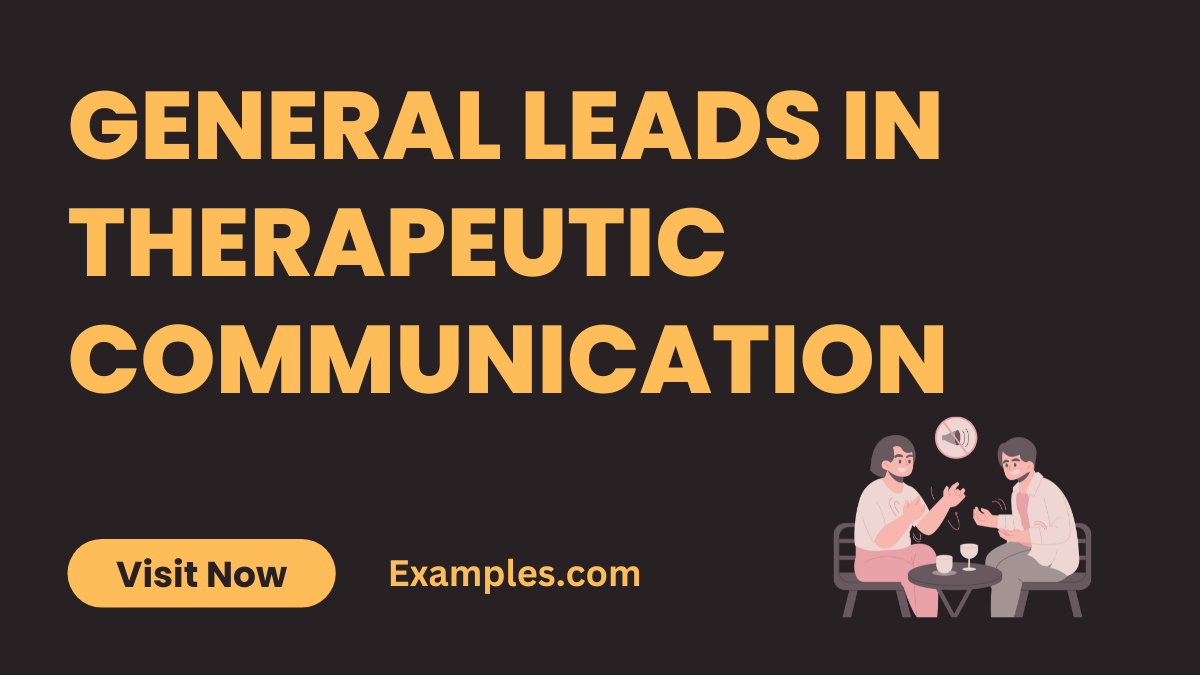19+ General Leads in Therapeutic Communication Examples
In the realm of healthcare, mastering therapeutic communication is indispensable. This comprehensive guide on “General Leads in Therapeutic Communication” unfolds the art of fostering meaningful connections between healthcare professionals and patients. Explore insightful examples that illuminate the nuances of effective communication. Elevate your understanding of this crucial aspect of healthcare by delving into real-life scenarios. Uncover the power of communication examples in establishing rapport, fostering trust, and promoting overall well-being. Harness the potential of therapeutic communication for transformative healthcare interactions.
What is General Leads in Therapeutic Communication?

In the realm of healthcare, “General Leads in Therapeutic Communication” encompass subtle cues and open-ended statements. These serve as inviting prompts used by healthcare professionals to encourage patient engagement. In simpler terms, they act as conversation starters, fostering a supportive atmosphere. These leads are vital in building trust and allowing patients to express themselves openly. This clear definition sheds light on the role of general leads, showcasing their importance in creating meaningful and therapeutic interactions between healthcare providers and patients.
What is the best Example of General Leads in Therapeutic Communication?

Within therapeutic communication, a stellar example of a general lead involves the use of open-ended questions. Imagine a healthcare professional asking, “Can you share more about how you’ve been feeling lately?” This type of inquiry invites the patient to express their thoughts and emotions freely, opening the door to a more in-depth conversation. By employing open-ended questions, healthcare providers demonstrate a genuine interest in understanding the patient’s perspective, fostering trust, and creating a supportive environment for meaningful dialogue. This detailed exploration highlights the efficacy and significance of employing such general leads in therapeutic communication.
20 General Leads in Therapeutic Communication Examples

In the realm of healthcare, mastering various general leads in therapeutic communication is essential. Explore our curated list of 20 examples, each designed to enhance patient-provider interactions.
- Open-Ended Questions: Encourage patients to share their feelings openly by asking questions that require more than a simple yes or no.
- Reflective Listening: Demonstrate empathy by paraphrasing and reflecting on what the patient has expressed.
- Affirmations: Acknowledge the patient’s strengths and efforts, fostering a positive and supportive atmosphere.
- Non-Verbal Cues: Utilize body language and facial expressions to convey understanding and compassion.
- Summarizing: Recap key points in a conversation, emphasizing active listening and understanding.
- Silence as a Tool: Allow moments of silence to give patients space to process and share at their own pace.
- Validation Statements: Affirm the legitimacy of a patient’s emotions, promoting a sense of being heard and understood.
- Paraphrasing: Rephrase what the patient has said to ensure mutual understanding and clarify any potential misunderstandings.
- Empathetic Statements: Express understanding and empathy towards the patient’s experiences.
- Exploring Ambivalence: Acknowledge conflicting feelings and help patients explore their emotions openly.
- Providing Choices: Offer options to empower patients and involve them in decision-making.
- Clarifying Questions: Seek additional information to ensure a comprehensive understanding of the patient’s perspective.
- Using Humor: Appropriately inject humor to lighten the mood and create a comfortable environment.
- Expressing Concern: Convey genuine concern for the patient’s well-being to build trust and rapport.
- Normalization Statements: Normalize the patient’s feelings to reduce stigma and encourage open communication.
- Encouragement: Motivate patients by highlighting their progress and strengths.
- Cultural Sensitivity: Acknowledge and respect cultural differences to ensure inclusive and effective communication.
- Focusing on Strengths: Shift the conversation towards the patient’s strengths and coping mechanisms.
- Exploring Goals: Discuss and understand the patient’s short-term and long-term goals for a holistic approach.
- Gratitude Expressions: Thank patients for sharing their experiences, reinforcing a collaborative and appreciative relationship.
Each of these examples empowers healthcare professionals to navigate conversations with sensitivity, fostering therapeutic connections and promoting overall well-being.
General Leads in Therapeutic Communication in Nursing Examples
In the nursing profession, mastering general leads in therapeutic communication is vital for building trust and promoting patient well-being. Explore these unique examples to enhance your nursing communication skills.
- Empathetic Listening: Demonstrate compassion by actively listening to a patient’s concerns without interruption.
- Positive Affirmations: Provide encouraging statements to uplift patients and reinforce their resilience during challenging times.
- Clarifying Patient Goals: Engage in conversations to understand and align with the patient’s health goals, fostering collaboration in care plans.
- Cue Recognition: Sensitively identify non-verbal cues to gauge a patient’s emotional state, addressing unspoken needs.
- Cultural Competence: Acknowledge and respect diverse cultural backgrounds, enhancing cultural sensitivity in nursing communication.
- Comfortable Silence: Allow moments of quiet reflection to create a space where patients feel safe to share their thoughts.
- Encouraging Expression: Use open-ended prompts to encourage patients to freely express their feelings and experiences.
- Strengths-Based Communication: Focus on highlighting a patient’s strengths and coping mechanisms to instill confidence.
- Building Rapport: Establish a genuine connection through friendly and supportive interactions, fostering trust between nurse and patient.
- Holistic Understanding: Seek a comprehensive understanding of the patient’s physical, emotional, and social well-being to provide holistic care.
General Leads in Therapeutic Communication for Patients Examples
Effective communication is paramount in patient care. Explore these examples of general leads tailored to enhance the patient experience and strengthen the provider-patient relationship.
- Acknowledging Patient Concerns: Validate and address patient concerns promptly, creating a sense of security and trust.
- Shared Decision-Making: Involve patients in healthcare decisions, empowering them to actively participate in their treatment plans.
- Gratitude Expressions: Express gratitude for patients’ commitment to their health, fostering a positive and appreciative atmosphere.
- Encouraging Questions: Welcome and answer patient questions to enhance understanding and alleviate concerns.
- Educational Conversations: Provide clear and informative explanations about medical conditions and treatment options.
- Personalizing Care: Tailor communication to each patient’s preferences, creating a personalized and patient-centric approach.
- Using Patient’s Preferred Language: Communicate in the patient’s preferred language to ensure clear understanding and convey respect.
- Promoting Relaxation Techniques: Share relaxation strategies to alleviate patient anxiety and enhance overall well-being.
- Respecting Privacy: Prioritize patient privacy and confidentiality, creating a safe environment for open communication.
- Empowering Through Feedback: Offer constructive feedback to empower patients in their health journey, emphasizing collaboration and progress.
How do you use general leads in therapeutic communication?
Mastering the art of employing general leads in therapeutic communication is essential for healthcare professionals seeking to enhance patient interactions. This comprehensive guide provides a step-by-step approach to effectively integrate and utilize general leads in the healthcare setting.
1. Understanding Patient Context: Before using general leads, healthcare professionals should grasp the patient’s background, preferences, and current emotional state. This foundational understanding informs the choice of appropriate leads tailored to the individual.
2. Selecting Appropriate General Leads: Choose leads that align with the patient’s communication style and comfort level. Options include open-ended questions, reflective listening, affirmations, and non-verbal cues. The selection should promote a supportive and non-judgmental environment.
3. Establishing Rapport: Begin conversations with a focus on building rapport. Use friendly greetings, maintain eye contact, and adopt a welcoming demeanor. Establishing a connection from the outset lays the groundwork for effective communication.
4. Active Listening Techniques: Engage in active listening by providing verbal and non-verbal cues that convey attentiveness. Nodding, paraphrasing, and offering reflective responses demonstrate genuine interest and understanding.
5. Adapting to Patient Responses: Flexibility is key in therapeutic communication. Adapt your approach based on the patient’s responses and cues. If a patient prefers a more direct communication style, adjust accordingly while maintaining empathy.
6. Encouraging Expression: Utilize open-ended questions to encourage patients to share their thoughts and feelings freely. Avoiding closed-ended queries promotes a more expansive and meaningful dialogue.
7. Creating a Safe Space: Foster an environment where patients feel safe expressing themselves. Use affirmations to validate their experiences, and assure them that their feelings are acknowledged and respected.
8. Promoting Patient Autonomy: Involve patients in decision-making by offering choices and considering their preferences. This empowers patients to actively participate in their healthcare journey.
9. Non-Verbal Communication: Leverage non-verbal cues, such as body language and facial expressions, to convey empathy and understanding. Non-verbal communication enhances the overall impact of general leads.
10. Reflecting on Interactions: After each interaction, reflect on the effectiveness of general leads used. Consider what worked well and areas for improvement. This reflective practice contributes to ongoing skill development.
What are the techniques for General Leads in Therapeutic Communication?

These techniques enhance therapeutic communication, fostering rapport and trust between healthcare providers and patients. Integrating these strategies into daily interactions contributes to patient-centered care and improved overall well-being.
1. Open-Ended Questions: Encourage expansive responses, fostering meaningful dialogue.
2. Reflective Listening: Demonstrate empathy by paraphrasing and reflecting on patient expressions.
3. Affirmations: Acknowledge strengths and efforts, creating a positive atmosphere.
4. Non-Verbal Cues: Utilize body language and expressions to convey understanding.
5. Summarizing: Recap key points, emphasizing active listening and comprehension.
6. Silence as a Tool: Allow reflective moments, promoting a comfortable sharing space.
7. Validation Statements: Affirm the legitimacy of emotions, fostering trust.
8. Paraphrasing: Rephrase to ensure mutual understanding and clarity.
9. Empathetic Statements: Express understanding towards the patient’s experiences.
10. Exploring Ambivalence: Acknowledge conflicting feelings, encouraging open exploration.
Tips for Effective General Leads in Therapeutic Communication?
Mastering the use of general leads is pivotal in fostering impactful therapeutic communication. Explore these concise yet powerful tips to enhance the effectiveness of your interactions.
- Tailor to Individual Preferences: Customize general leads based on the patient’s communication style and comfort level for a more personalized approach.
- Maintain Non-Judgmental Attitude: Foster an open and non-judgmental environment, allowing patients to express themselves without fear of criticism.
- Start with Open-Ended Questions: Initiate conversations with open-ended questions to encourage patients to share their thoughts and feelings openly.
- Utilize Reflective Listening: Engage in reflective listening by paraphrasing and acknowledging the patient’s emotions, demonstrating empathy.
- Adapt to Verbal and Non-Verbal Cues: Stay attuned to both verbal and non-verbal cues, adjusting your communication approach to align with patient responses.
- Establish Rapport Early On: Build rapport from the outset with friendly greetings, maintaining eye contact, and creating a welcoming atmosphere.
- Promote Patient Autonomy: Involve patients in decision-making by offering choices, empowering them to actively participate in their healthcare journey.
- Create a Safe Space: Foster an environment where patients feel safe expressing themselves, using affirmations to validate their experiences.
- Encourage Expression: Use open-ended prompts to encourage patients to share their thoughts and feelings freely, promoting a more expansive dialogue.
- Reflect on Interactions: After each interaction, reflect on the effectiveness of general leads used, identifying strengths and areas for improvement.
In conclusion, mastering the art of employing general leads in therapeutic communication is paramount for healthcare professionals. This comprehensive guide has explored the significance of these leads, providing practical examples to enhance communication skills. By incorporating these strategies, practitioners can create a supportive environment, fostering meaningful connections that contribute to improved patient outcomes and satisfaction



